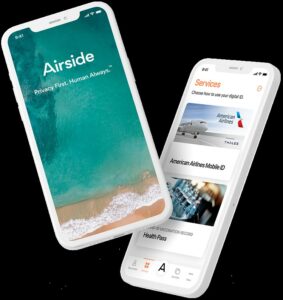For international travelers, the Mobile Verify system from Airside Mobile means that passport identification steps can be bypassed, reducing the number of queues in the airport before a flight.
Oct 15, 2023To streamline passenger check-in at airports, Alaska Airlines has released an NFC-based service called Mobile Verify that allows international travelers to complete their passport verification process before they even enter the terminal. The process requires users to have the Airside Digital Identity App from Airside Mobile, take a selfie, and access passport data by reading its built-in NFC chip with their smartphone. The data is received, verified, and stored on the user’s phone. Once in the airport, they can move directly to check their bag and complete the TSA screening. Alaska released the solution on August 29.
 While much airline travel has already become more automated (with check-in accomplished at home and boarding passes and even baggage tags accessed before coming to the airport), international flying requires another step. Traditionally, passengers must present their passport to an agent who reviews and verifies it, including comparing the passport photo to the face of the person checking in.
While much airline travel has already become more automated (with check-in accomplished at home and boarding passes and even baggage tags accessed before coming to the airport), international flying requires another step. Traditionally, passengers must present their passport to an agent who reviews and verifies it, including comparing the passport photo to the face of the person checking in.
Depending on where and when a passenger travels, waiting for document verification at some international locations can be up to 90 minutes, says Alison Sural, Airside Mobile’s head of marketing and customer success.
This was a delay Alaska has been targeting to streamline passenger check-in. The airline has been reviewing the entire travel journey for passengers to find the main pain points related to time spent at airports. It found that passengers first arriving for their flight were often met with time-consuming processes in the lobby before they could proceed through the rest of their journey.
“We have a goal of getting guests through the lobby in five minutes or less, and we’re going to do that by reducing the time guests spend in lines,” says an unnamed Alaska Airlines spokesperson. One effort has been the removal of kiosks previously used by passengers for checking in and printing boarding passes. Travelers are expected to accomplish those steps on their own before the flight.
However, the airline also saw an opportunity to use technology to eliminate the passport verification process. “Technology now makes it possible for guests to take care of that process from the comfort of their own home before they even get to the airport,” the spokesperson says. That means leveraging technology already built into U.S. and Canadian passports – an NFC chip.
Verifying a Passport at Home
 It works like this: the passenger must be a U.S. or Canadian passport holder and aged 13 or older. They first download the Airside Digital Identity App and create their digital identity.
It works like this: the passenger must be a U.S. or Canadian passport holder and aged 13 or older. They first download the Airside Digital Identity App and create their digital identity.
To do so, they input their personal information, take a selfie, and then read the NFC (13.56 MHz) tag with their smartphone, compliant with ISO 14443, built into the passport. The app collects selfies and passport data and compares photos to confirm the passenger’s identity. That identity will remain on the user’s phone and is not stored on Alaska Airlines’ or Airside Mobile’s servers.
Before their journey, the passenger opens the app, selects Alaska Airlines “Mobile Verify, “and consents to share their digital identity for that flight. The solution does not eliminate all the steps passengers must pass through. For example, if they need to check a bag, they will still have to provide identification to an agent before they go through TSA screening. They would also still need to show an ID at that security checkpoint.
The service can only accept consent for one flight at a time, so they must reshare their verified passport from the app before their return flight.
Leveraging the NFC Chip in Passports
Many worldwide passports have NFC technology built into them. The International Civil Aviation Organization’s (ICAO’s) 9301 document requires machine-readable capability for travel documents. As part of that standard, passports that follow the latest guidance include an electronic chip that is NFC readable.
According to ICAO, more than 140 states and non-state entities, including the U.S. and Canada, are issuing ePassports with a chip with biographical and biometric information encoded on it. There are, in fact, over 1 billion such ePassports in circulation.
 Under ICAO 9303, the chips within ePassports have two “vaults,” Sural explains. The first one includes the same information on the passport’s printed page, such as name and date of birth, plus a higher-resolution version of the picture of the passport owner. That first vault is accessible by anyone with physical access to the passport with the right reader and software. Still, data can only be opened by using a key generated based on the information contained in the MRZ (Machine Readable Zone) of the passport data page, says Sural, and applying a calculation to that MRZ string.
Under ICAO 9303, the chips within ePassports have two “vaults,” Sural explains. The first one includes the same information on the passport’s printed page, such as name and date of birth, plus a higher-resolution version of the picture of the passport owner. That first vault is accessible by anyone with physical access to the passport with the right reader and software. Still, data can only be opened by using a key generated based on the information contained in the MRZ (Machine Readable Zone) of the passport data page, says Sural, and applying a calculation to that MRZ string.
The second vault on the chip includes additional information, such as more personal details about the passport holder. This information varies among the issuing states, Sural says. In some cases, they also can include additional biometrics, such as the images of all 10 fingerprints. That second vault is fully encrypted, with keys only the issuing state can access. Very rarely does the issuing state share those keys, even with security or immigration agencies of other countries (sometimes not even within the agencies of the issuing government), she explains.
Airside complies with ICAO and ePassport security requirements and the National Institute of Standards and Technology (NIST) NIST 800-63-3 guideline for identity assurance. She points out that NIST is “the US government’s highest level of certification for citizen-facing identity proofing.”
In the meantime, digital identification will continue to expand in airports, Sural predicts. The TSA is expanding its rollout of CAT-2 reader equipment for the fast and secure use of mobile IDs at the checkpoint; “This means that the Airside App could be used at thousands of locations shortly.”
According to a 2021 survey from the International Air Transport Association (IATA), 73 percent of passengers are willing to share their biometric data to expedite travel processes and spend less time in lines. That’s up from 46 percent from a similar survey conducted two years before.
“The Mobile Verify program provides incredible opportunities to make the travel experience less stressful and more enjoyable,” the Alaska Airlines spokesperson says. “We’re looking forward to expanding how our guests can use the technology in the years ahead.” Airside provides a similar solution with the American Airlines mobile ID service.
Key Takeaways:
- Alaska Airlines’ international passengers from the U.S. and Canada can scan their NFC-enabled passports at home to accomplish passport verification.
- With the Airside Digital Identity App, they can skip one line while checking in and boarding their flight.

